A curated list of the most important Rome symbols in the past and present. Symbols of Rome for kids, students and curious visitors.
Rome is a city rich in symbols.
The Ancient Romans were proud of their symbolic representation of Rome, its people and Roman Gods.
They left us many sculptures and depictions of Rome Symbols that are beautiful, unique and significant as they allow us to understand how they saw and perceived their city.
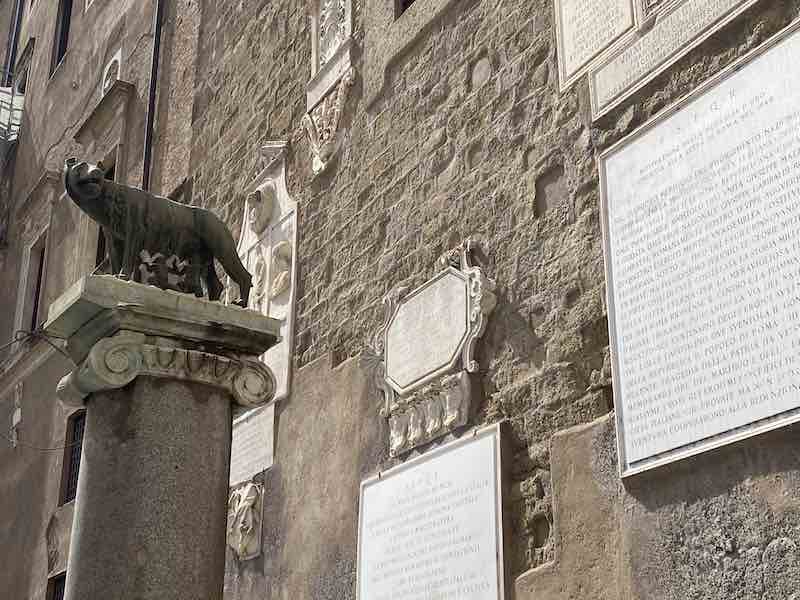
The symbols of Rome have a history as long as that of the city.
Some symbols of Rome date back to the ancient Republican Times.
Some took hold during imperial times and some were so successful they outlived the Roman civilization as such as remained in use during the middle age, the modern and even contemporary era.
In this article, we will look at the most important symbols of Rome that you may still encounter in the city of find in Roman writing and history books. This is an introduction to the main symbols of Rome for kids, students and curious visitors.
Rome symbols and Symbols of Rome
When talking about Rome symbols, we need to make a distinction.
Some Rome symbols are symbols of Rome as a city. Others are symbols of power in ancient Rome and are symbols of Rome as a civilization, not the city.
This distinction may seem pedantic but it isn’t.
The only symbol of Rome city is the she-wolf, while other symbols highlight the power or military prowess of the roman civilization or empire but not the city as such.
I am a Roman History graduate and, growing up in Rome, I quickly developed an interest in Roman symbols and their meaning.
In this essential guide to Rome symbols, we will learn about the main symbols of Rome city, other ancient roman symbols for the empire, roman mythology symbols and later symbols you find around Rome that date from later times, such as the Renaissance.
The most important ancient symbols of Rome and their meaning: chart
| Symbol | Meaning |
| She-wolf nursing two twin babies | Symbol of Rome City |
| SPQR acronym | Senatus Populusque Romanus (acronym meaning: The Senate and the People of Rome), used on public monuments |
| Eagle | Symbol of the Roman legion (military) and the symbol of the Roman Empire |
| Fasces | Ancient Rome Symbol of lawful order |
| Globe | Symbol of universal power |
| Laurel Tree | Symbol of the God Apollo and vistory |
What are some symbols of ancient Rome? Symbols of ancient Rome, their story and meaning
The she-wolf (Capitoline wolf)
The she-wolf is the main symbol of Rome since ancient times. She is represented as standing, with her head slightly turned towards her back, and in the process of nursing two babies, who sit under her, reaching for her milky breasts.
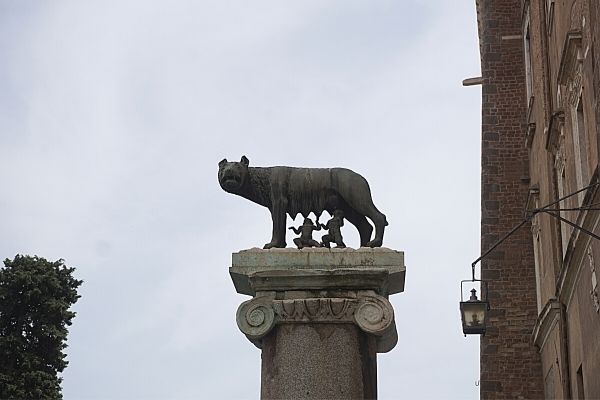
The she-wolf may seem an unusual symbol but has a compelling meaning and had considerable importance in making the Roman people accept the legitimacy of imperial power.
The legend tells us that the future Founder of Rome, Romulus and his brother Remus were abandoned as babies and put in a basket to float on the river Tiber.
A she-wolf found them and nurtured them back to health until the local shepherd Faustulus adopted them.
You cannot underplay the symbolic importance the she-wolf had in the history of Rome.
Romulus was the son of Rhea Silvia, a descendant of Aeneas and the God Mars.
Recalling his origins meant putting Rome and its emperors in direct connection with two of the most powerful gods of the Roman pantheon, the divine powers of Love and War.
The story of the she-wolf and Faustulus rooted the story in the geography of Rome and the river Tiber, solid memory of the place where the growth of Rome started and the exceptional importance Rome and the Italian peninsula had, especially at the beginning of imperial times.
You can read the entire legend of the she-wolf here and you can learn where to the see Roman wolf in Rome here.
The acronym SPQR
Walking around Rome, you often come across the acronym SPQR, used in ancient and contemporary buildings alike.
SPQR stands for Senatus PopulusQue Romanus, which means the Senate and The People of Rome and we find it on ancient coins and monumental inscriptions.
SPQR is also on ancient and medieval buildings and constructions with official standing and use. Notably, you can see them nowadays on manholes and trash cans, both of public use!
Good to know: in origin, the acronym stood for Senatus Populus Quirites Romanus. This origin may explain the presence of the letter Q, which would not have been part of the acronym had it always been Senatus Populusque Romanus.
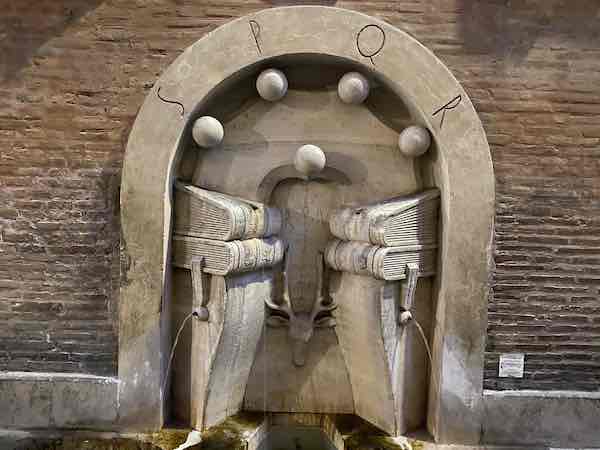
The Eagle and Roman insignia
One of the most beloved and respected symbols of Rome in ancient times was the Eagle, animal sacred to the God Jupiter.
The Eagle was the symbol of the legion, the core of the Roman military organization, and it was carried into battle as a powerful insignia (roman signs / roman emblems).
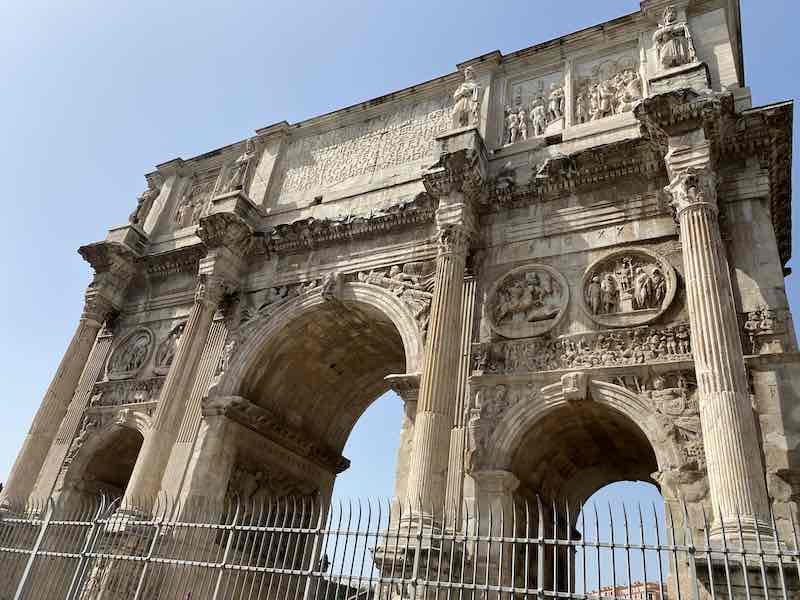
Defending the Eagle was of paramount importance to the Romans and their loss would bring eternal dishonor.
Notably, in 9AD, the legion of Varus lost the battle of Teutoburg and, on that occasion, their Eagle.
The event was no grave, the number indicated the legion was never reassigned to new soldiers for fear of it being a bad omen.
Need to know! In origin, the Eagle wasn’t the only animal associated with the Roman legions. Others such as the wild boar or the minotaur and the horse were also in use. However, Gaius Marius gave preference to the Eagle, which, since then, acquired almost religious meaning.
In imperial time, the Eagle with spread wings became a symbol of Roman power and specifically of the empire.
This is the use of this symbol of Rome by later movements such as fascism made their own as a Rome symbol of power.
Good to know: when represented with a double head, the Rome eagle symbolizes the unity of the two parts of the Roman Empire, the east and the west, after their division.
The Fascia (fasces)
The Roman fascia (fasces) are a bundle of long wooden rods laced together and often surmounted by an ax.
The fasces were the symbols of the power of the magistrates and of legal order.
They date back to Roman Republican times when the magistrates’ roles and the cursus honorum were set.
Two lictors accompanying the magistrate carried them, and they were therefore called Fasci Littori.
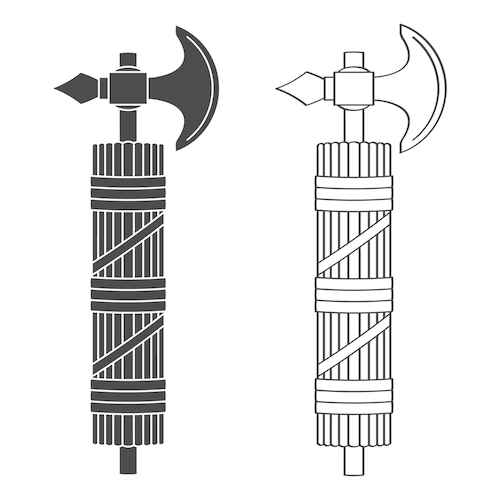
It is significant to notice that while the fasces have been associated with absolute power in more modern times, this was not the case in ancient Rome.
Even the magistrature of the dictator in Rome was within the law and was subject to strict regulations, so the fasces are not a symbol of arbitrary and coercive power but of lawful order.
This original meaning is also behind the adoption of the fasces as a symbol during the french revolution and in American democracy (statue holding them): their use by Mussolini, while often the best known, is also the least loyal to the original meaning of this symbol in Rome.
Good to know: the ax was a powerful religious symbol in ancient Crete and in Greek Mythology. It was called labrys and had a strong connotation as a feminine power. In Etruscan times, it became the symbol of the sacrality of the social pacts and, as such, passed into Roman symbolism. The version with two blades is called bipenne.
The globe
Ancient Roman coins and many statues in Rome show influential figures holding a globe in their hand as a Rome symbol of power. The globe was one of the most successful roman symbols and has been largely used by monarchies in Europe to represent power and wisdom.
Laurel tree
In ancient Roman times, the laurel tree symbolizes the god Apollo and is a symbol of triumph.
Laurel has been described as sacred to Apollo already in greek mythology and the Romans maintained this use: laurel is represented in triumphal crowns as a sign of victory and was also in use ornamental plant in the times of the roman empire.
The most notable example of this was the Mausoleum of Augustus, which was decorated with laurel and poplar plants.
Good to know: many other plants had symbolic meaning in ancient Rome. They are used extensively as meaningful decoration on the Vittoriano: you can read all about them here.
Modern symbols of Rome
As well as ancient Roman symbols, there are nowadays many landmarks in Rome that are so unique to now be effectively considered symbols of the city.
The most important are the Colosseum and, while technically a different country, the Vatican: the distinctive silhouettes of these two monuments evoke and symbolize Rome in anything from tourism brochures to local logos of restaurants and shops!
Roman mythology symbols
Roman mythology is rich in characters who become powerful symbols of natural forces, human conditions and cautionary tales.
In this sense, all Roman Gods have symbolic meaning. Therefore, the best way to learn about them is to learn Roman myths and legends. At a very quick glance, we can recall:
- Venus, Roman goddes of love and beauty, symbol of love as a generating force – usually represented as a beautiful woman, often accompanies by Cupid, in the form of a young boy with a bow
- Mars is the Roman God of war, symbol of war and destruction
- Apollo is the Roma God of the Sun, symbol of the sun and light – his symbol was the laurel tree
- Minerva is the Roman Goddess of knowledge symbol of knowledge, often represented as a woman in full armour
- Mercury is the Roman God of trade and commerce, symbol of connections
- Asclepius is the Roman God of medicice, symbol of regeneration and health, often represented with a snake clumbing a rod (this is still nowadays the symbol of pharmacy shops!)
- Jupiter, Rome supreme God, symbol of all power: his symbols were the eagle and lighting
- Juno, Roma Goddess of the sky, birth and marriage, a symbol of feminine power and birth
Other Roman symbols you will see in the city
The Rome Coat of arms (scudo) – the symbol of Rome today- is a coat of arms surmounted by a crown and with the acronym SPQR. You find this symbol on all official communications by the municipality administration, and you see it often represented on fountains and public use monuments and buildings.
Asclepius Rod – not a symbol of Rome but a symbol of the God Asclepius, it shows a snake climbing a rod. This is a powerful Greek and Roman symbol of renewal and health.
XRho – this is a Christian symbol of Christ, introduced by Constantine I the Great after his conversion.
Fish – again, not a symbol of Rome but a symbol you find in Rome and that represents Christ. The word ‘fish’ in ancient Greek reads ‘Ichtus,’ acronym of Iesus Xristus Teios Uios Soter (Jesus Christ Son of God Savior)
Bees – Bees are not a symbol of Rome city. Instead, they represent the Barberini family; they are on most sculptures commissioned by them, such as the barcaccia by Bernini, one of the most famous fountains in Rome.
I hope you enjoyed this quick overview of symbols of Rome and symbols you can see in Rome city!
